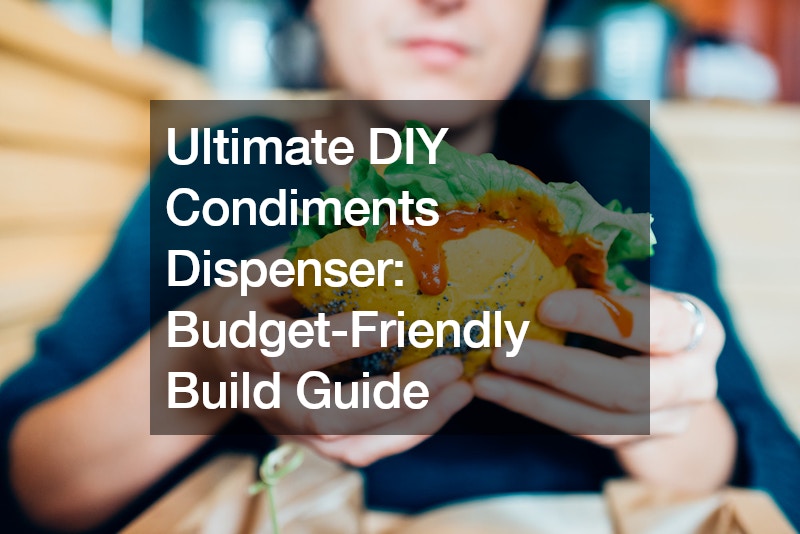Elevate your kitchen counter or picnic setup with personalized flair and functionality! This guide unveils creating a fantastic DIY condiment dispenser using readily available materials. This budget-friendly project is perfect for anyone who enjoys little arts and crafts while saving money.
The Perks of DIY Condiments Dispensers
There are numerous advantages to crafting your condiment dispensers:
Customization: Tailor the design and materials to match your kitchen decor or personal style. Cost-Effective: Repurpose everyday items for a budget-friendly alternative to store-bought dispensers.
Eco-Friendly: Give new life to used materials, reducing waste and promoting sustainability. Multifunctionality: These dispensers can hold various condiments, from ketchup and mustard to olive oil and balsamic vinegar. Sense of Accomplishment: Enjoy the satisfaction of creating a practical and visually appealing kitchen accessory. Materials You’ll Need
The beauty of this project lies in its flexibility. Here’s a list of commonly used materials, with substitutions encouraged to suit your creativity:
Primary Dispensers: Glass Bottles: Mason jars, recycled glass bottles from juice or kombucha, or similar containers with airtight lids.
Plastic Bottles: Empty squeeze bottles from condiments or sauces can be repurposed if a more portable option is desired. Upcycling Inspiration: Wine bottles, glass jars from food items, or even empty plastic soap dispensers can be potential candidates with a little creativity.
Decoration (Optional): Paint: Acrylic or spray paint to transform your chosen containers into a cohesive set. Washi Tape: For a quick and colorful decorative touch. Twine or Ribbon: Add a rustic or elegant touch by tying twine or ribbon around the dispenser neck. Labels: Create custom labels using a label maker, stencils, or handwritten tags. Tools You’ll Need
The required tools are minimal and readily available in most households:
Bottle Opener (if using capped bottles): To remove existing lids or caps. Paintbrush (Optional): For applying paint for decoration.
Scissors (Optional): For cutting twine or ribbon.
Drill (Optional): If your chosen container lids lack a dispenser opening, a drill with an appropriate bit size will be needed.
Building Your DIY Condiment Dispenser: Step-by-Step Guide
Prepare Your Chosen Containers: Wash the bottles or jars thoroughly with warm, soapy water and ensure they are completely dry before proceeding.
Decorate (Optional): This is where you can unleash your creativity! Paint the containers using a solid color or create a fun design. Washi tape offers another quick and easy way to add a decorative touch. Lids and Dispensing Mechanisms: Most repurposed bottles or jars will already have lids. However, if you’re using a container without a built-in dispenser, you’ll need to create one. Here are two options: Option 1: Using Existing Lids: If the existing lid has a removable cap, drill a small hole in the center to create a dispensing point.
Option 2: Replacing Lids (Optional): Purchase lids specifically designed for dispensing liquids. These lids typically come with pump tops or squeeze nozzles and can be found at craft stores or online retailers.
Labeling (Optional): Create labels for your dispensers to identify the contents. You can use a label maker, stencils, or handwritten tags for a personalized touch. Fill and Enjoy! Fill your dispensers with your favorite condiments, ensuring the lids or nozzles are secure. Your DIY condiment dispensers are ready to add functionality and style to your kitchen or picnic setup. Additional Tips and Variations
Tiered Stand: For a more organized and space-saving approach, consider creating a tiered stand using recycled materials like wood or cardboard to hold your dispensers. Mason Jar Variations: Mason jars offer a particularly versatile base for DIY dispensers. You can add decorative touches like twine wrapped around the jar neck or paint the lids with chalkboard paint for a rustic look and easy labeling. Squeeze Bottle Options: If using repurposed plastic squeeze bottles, ensure they are made from food-grade plastic and BPA-free materials. You can also decorate them with paint or markers for a personalized touch. Safety Considerations
When drilling holes in lids, ensure proper ventilation and wear safety glasses to protect your eyes from flying debris.
If using repurposed plastic bottles, ensure they were previously used for food-grade products and are BPA-free. Label your dispensers clearly to avoid confusion, especially if using them for look-alike condiments like mustard and sriracha. Regularly clean your dispensers with warm, soapy water to maintain hygiene and prevent build-up. Conclusion
This DIY condiments dispensers project is a fun and rewarding way to personalize your kitchen accessories while saving money. You can create practical and visually appealing dispensers that will elevate your dining experience by utilizing readily available materials and a touch of creativity. Remember, the possibilities are endless! Experiment with different materials, unleash your artistic side and enjoy the satisfaction of crafting something useful and stylish for your kitchen.
.


